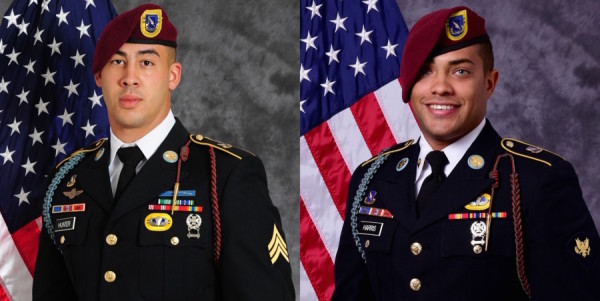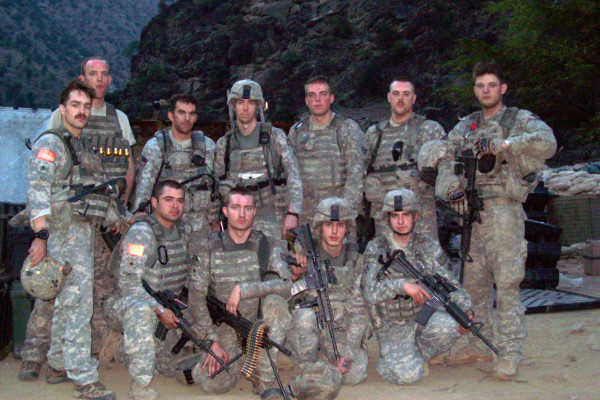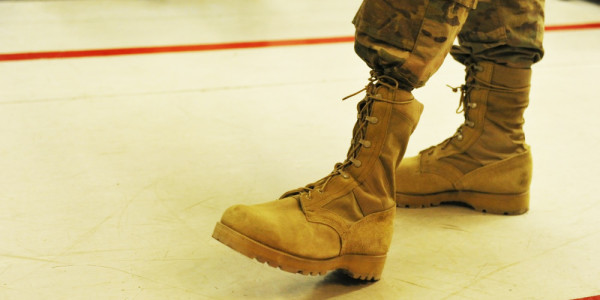Spc. Robert Rolando was dropping off equipment at Abbey Gate — a main entrance on the east side of the Hamid Karzai International Airport (HKIA) in Kabul, Afghanistan — on Aug. 26 when he started talking with one of the Marines standing nearby.
He doesn’t have many Marine friends since the 24-year-old infantryman, assigned to 1st Brigade Combat Team, 82nd Airborne Division, hasn’t spent much time around other military branches. Not to mention that his deployment to HKIA was his first.
But as he and the Marine started chatting, they traded things like patches and water bottles. Rolando gave him a chocolate bar he had. They shared phone numbers and planned to reconnect once they returned home. It was the first and last time they would meet.
Later that same day, Rolando and other soldiers heard a bomb go off where they had been hours earlier at Abbey Gate. A suicide bomber believed to be affiliated with ISIS-K had weaved through the crowd of civilians and detonated an explosive vest, killing 13 U.S. service members, including an Army special operations soldier, a Navy Corpsman, 11 Marines, and more than a hundred Afghan civilians.

The Marine that Rolando had befriended just hours earlier was among those slain in one of the deadliest attacks on U.S. troops as the 20-year-war drew to its end. Rolando had never lost a friend in combat before. Until that day, the chaos of war and the aftermath of a deadly attack — those had been abstracts. When Rolando returned to Abbey Gate that day, they became real.
“Later, we came back [to Abbey Gate] and he wasn’t there anymore,” Rolando said of the Marine. “A couple of the other guys were there, we were talking, and … I found out he was one of the ones who died in the explosion.”
Rolando and three other soldiers from 1st Brigade spoke to Task & Purpose in October about their experiences during their deployment to HKIA. Sitting in a circle inside a spare office at Fort Bragg, North Carolina, in an effort to find somewhere quiet, they spoke of the chaos in those final days. The soldiers recounted the seemingly impossible situations they found themselves in, the difficult decisions they had to make and the conversations they were forced to have. They recalled declining to take children into the airport despite pleas from desperate parents and having to turn away frantic civilians without passports, directing them to their local government leaders, all while watching that same government crumble before their very eyes.
Like Rolando, two other specialists who spoke with Task & Purpose were also in their early 20s and on their first deployment. They tried to prepare themselves by listening to other soldiers who had deployed before and offered advice on the flight to Afghanistan — “expect the worst,” they were told, “it’s war.”

Hearing about war and experiencing it first hand are, of course, very different. And some things that happen in combat, like losing a friend for the very first time, are impossible to fully prepare for.
“I’ve been in the Army almost four years now and this is my first deployment, and I’d never lost somebody that I was close to,” Rolando told Task & Purpose. “I guess that was the closest — and it’s not the same of course, his friends and family feel a lot different — but the fact that I made a friend and then literally hours later, you find out they just got killed. It’s pretty horrible.”
‘I get why they did that. They were so scared to be in their own country.’
The situation the 1st Brigade soldiers were mentally preparing for on their flight to Afghanistan was nothing like the one they saw when they got there.
A battalion with the 82nd Airborne Division was rerouted to Kabul from their original destination of Kuwait on Aug. 14, joining a few thousand other troops who were ordered to Afghanistan as the capital quickly fell under Taliban control. One soldier who spoke with Task & Purpose, Spc. Dylan Brantley, a 26-year-old infantryman, said he arrived on Aug. 14. Spc. John Paul Buckler, a 23-year-old fire control specialist, recalled landing a day later and Rolando believes he got in on the 15th or 16th — as one can imagine, the days were running together.

But they each said they expected that the environment would be hectic when they landed, with civilians potentially crowding the airstrip and the enemy waiting for them the moment they touched down.
“We were weapons hot coming off the plane,” Rolando said. But what they found on the airstrip was, well, nothing. It was quiet, calm almost. There was a group of Marines doing maintenance on a helicopter “as if nothing was wrong,” Rolando said. It was frankly a bit jarring, but also a welcome moment of peace.
As they recalled walking off the aircraft and onto Afghan soil for the first time, the three soldiers spoke casually, like they were recounting a routine day at Fort Bragg and not the beginning of what was going to be a historic end to two decades of war.
“It was nice,” Brantley said. “Everyone was so tensed up on the bird —”
“We were standing up and praying for each other, stuff like that,” Buckler matter-of-factly interjected.
“I’ve spent a lot of time in Colorado, and we landed and I’m looking around these beautiful, giant mountains,” Rolando added. “It was like Fort Carson, like this reminds me of home. It was beautiful.”

That reprieve only lasted for so long. The soldiers quickly learned that the equipment they were accustomed to, like their MRAPs and M-ATVs — up-armored gun trucks — weren’t coming into Afghanistan. The focus was getting troops into Kabul, which left little room on the planes for heavy equipment. So the soldiers began looking for other vehicles around the airport they could use: they found demilitarized U.S. vehicles and trucks the Afghan military handed over, SUVs, a tow truck, and in one noteworthy instance, a Toyota pickup outfitted with a Russian anti-aircraft gun, as well as a Mercedes G-Wagon.
And then they jury-rigged whatever they could find to mount weapons to them, Rolando said. “It was definitely a lesson in readiness and versatility,” but it wasn’t necessarily a new challenge.
“We’re kind of in an environment where our trucks break down all the time,” he said. “And we’ve got to adapt and figure things out, and that’s here, locally.”
That first day was spent getting their equipment sorted, and their hodge-podge of acquired vehicles suitably armed and ready. They had only just finished when a sergeant told them that the airport was breached. Tens of thousands of Afghan civilians had pushed past security and climbed over concertina wire around the perimeter of the airport, and were rushing the airfield. The U.S. troops on the ground were vastly outnumbered. At one point, Brantley and three other soldiers turned a corner expecting to see a handful of Afghan civilians who had broken past the perimeter. What they saw, Brantley estimated, was a crowd of more than 25,000, and those numbers only grew.

From afar, the rest of the world watched as desperate Afghans flooded the airstrip, climbing onto Air Force C-17 Globemasters on the runway, in some cases clinging to the wheels as the planes took off before plummeting through the air minutes later. In at least one case, the Air Force later said a body was found in the wheel well of a plane after leaving Afghanistan.
For hours, troops at HKIA worked to push people back off the airfield, trying to assure them that they’d be safer off the airstrip. By the end of it, the soldiers felt defeated. They were exhausted, slathering sunscreen on when they could to avoid sunburn, chugging hot water from plastic bottles that had been sitting out in the sun. Rolando recalled seeing his platoon leader’s blonde head sticking up above a crowd of civilians as they moved closer to him, begging for his help. He was a “brand new second lieutenant,” who was a new addition to the company and “didn’t really know our guys,” Rolando said. The specialist pushed through the crowd and grabbed the lieutenant’s collar, pulling him back in order to regroup with the rest of their platoon.
“It was nerve-racking,” Rolando said. “These are people I’ve been talking to for 6 or 7 hours that are now coming to me, this far away from my face,” Rolando said, his hand outstretched several inches “pleading and begging and asking, ‘please put us on a plane, please get us out of here.’ And it was just everything we could do to say ‘please try to stay out of the sun, stay in the shade, stay safe, if you hear shooting move the other direction but don’t push past the barbed wire.’”
They’d only just gotten the crowds back when what felt like 30 seconds later, people were rushing the airfield again.

It wasn’t just the physical work that wore the soldiers down, it was the mental toll of attempting to comfort desperate people willing to do anything, and telling them to go back to the gates of the airport, closer to the armed Taliban fighters outside — the very people they were trying to escape, and the same enemy the U.S. military had fought for two decades. Rolando said he “felt horrible” every time he had to tell someone to get away from the airstrip and the planes — he understood they were grasping at hope.
“It was just hard,” Brantley added. “I get why they did that. They were so scared to be in their own country.”
Eventually, they were able to rest. Rolando said he got lucky; he and other soldiers were set up in a nice room with a television. They watched as the day’s events unfolded before them again, this time on the news.
“They reported, ‘60,000 people rushed the airstrip,’” Rolando recalled. “We were like no that didn’t happen — it was a lot more than that.”

‘Here I am looking at a kid that got cut with a machete, it’s just — it was a big wake-up call’
It wasn’t the last time those soldiers said they saw a break in reality between what they saw on the ground, and what they were hearing on the news. While U.S. officials assured the American public, and the world at large, that the Taliban were preparing “to provide safe passage of civilians to the airport,” soldiers at HKIA saw something else entirely.
In one instance, Rolando, who worked as a paramedic before joining the Army, said he was acting as a stand-in after the squad’s actual medic got heatstroke. A family handed him a two-year-old boy with a large cut on his arm, wrapped in a headscarf. Rolando asked the mother, who spoke English, what had happened. “The Taliban hit him with a machete,” Rolando recalled her saying.
“To hear that, and then see on the news at night that the Taliban are trying to be peaceful and make this transition good, but then here I am looking at a kid that got cut with a machete, it’s just — it was a big wake-up call,” Rolando said. He did his best to patch up the little boy — he didn’t have stitches, all he could do was clean the wound and bandage it. Afterward he pointed the family in the direction of a field hospital that had been set up nearby.

While at times it felt there was little comfort they could provide to the people they were trying to help, the moments when they could meant everything. Rolando said when he handed the little boy back to his family after treating him the best he could, the crowd around them clapped. He was stunned that, as terrified as they were, they would do such a thing. And when he used the limited Pashto or Farsi that he picked up from translators or other civilians, he saw it “was huge” for the person he was speaking with. “They were so happy you were trying to communicate.”
The good moments stand out, of course, because they were few and far between. Every win was worth holding onto. Seeing people overwhelmed with joy and relief as they came into the airport because they knew they were safe meant everything, the soldiers said.
‘We sent all of them to Abbey gate’
On Aug. 26, the soldiers were spread out around HKIA. Spc. Buckler, the fire control specialist with 1st Brigade, had been working at Abbey Gate in the days leading up to the attack. It was “so hectic,” he said, but that Thursday, he and other soldiers were told they weren’t needed there.
Meanwhile, Spc. Brantley and his team were providing security at another gate when a group of civilians approached.
“They were trying to figure out what gates to use to get in, and we sent all of them to Abbey Gate,” Brantley said, his voice shaking. “Before the explosion.”

After the attack, Buckler said many of the soldiers he was with — the ones who had been told they weren’t needed at the gate — wished they’d been there, thinking maybe something could have been different if they had. Despite the security they knew existed at the gate — Rolando said he had previously spoken with the Marines about the protective measures they had in place, and said he knew they were doing “everything they could to stop something like that from happening” — there was still a sense of what if? It’s not uncommon for those who live through a deadly event to carry misplaced feelings of guilt, or even shame, often called survivor’s guilt.
In the aftermath of the attack, Rolando said their command team was “very, very good” about acknowledging the pain of what had just happened and encouraged soldiers to talk with the chaplain. But they still had a job to do, and going forward it appeared that the tragedy forged an even stronger bond, both between different services and between the U.S. forces and their international partners on the ground.
Capt. Cody Chellman, the public affairs officer for the 1st Brigade, said he didn’t think “anybody saw service [branches] after that.”
“It was a somber moment,” he said. “There wasn’t a Marine Corps, there wasn’t a Canadian force or an international force — it was just one team, brother and sister in arms.”

‘I feel like I let down a 20-year generation of soldiers’
As the Aug. 31 deadline for the withdrawal neared, U.S. troops began boarding C-17s and departing the country. It was an eerie thing, Rolando said, seeing the number of American service members on the ground grow smaller and smaller and smaller, all the while watching the place he’d help protect for nearly two weeks slowly empty out.
The day before the withdrawal deadline, Rolando’s time at HKIA came to an end. As he boarded a plane, Brantley — who would leave on the last flight out just hours later — stayed behind. He was needed to work on the trucks they’d commandeered earlier. It was weird seeing his teammates, and friends, remain as he prepared to leave, Rolando said.
“Watching those guys stay there definitely was weird. You almost felt like you had to say goodbye because you weren’t sure you were going to see them again. It was quiet. It was weird,” he said. “Especially after how intense that initial Monday was and how intense some of those quick reaction force missions were — it was very, very weird.”

Buckler agreed that it was unnerving. But ultimately, everyone did depart, marking an official end, not just to the withdrawal, but to the war — a war that, for some of them, lasted a matter of weeks. But somehow, it didn’t feel over, not really. For Rolando, it felt more like “an open-ended question” than anything else, he said.
Brantley felt relief boarding the plane to go home, but it was harder to process that knowing how many other people weren’t going to get that opportunity.
Since coming home, Rolando said he’s caught himself filtering things out of his experience when he tells loved ones about that deployment. His parents called when he returned and he said he instinctually wanted to protect them from what he’d seen and experienced. There’s no shortage of lingering feelings about the deployment, and unanswered questions about what happens next in Afghanistan, especially with those the U.S. were unable to evacuate in time. Efforts to save vulnerable Afghans trapped under Taliban rule are still ongoing, though in smaller volume and often behind the scenes with the help of private groups and organizations.

But it’s also clear that questions remain about what this means for them, for the men and women who were there, many of whom are arguably too young to have to shoulder what happened over those two weeks. Too young to have to calmly yet firmly tell a sobbing mother that no, they can’t take her infant son or daughter with them, and no, they can’t bring her into the gates just yet.
Too young to feel that the outcome of a 20-year-war, a war started while many of them were children themselves, was somehow up to them. A feeling that, while not particularly fair, keeps with a long, painful tradition upheld by those who came before them and who shoulder a similar burden from the same war.
As the interview neared its end, and the soldiers recounted their feelings about leaving Kabul once and for all, Rolando expressed bluntly how he felt now that it was over:
“I feel like I let down a 20-year generation of soldiers that have been fighting there. We kind of just handed over a country on a platter.”
Brantley and Buckly, on either side of him, looked at their feet.
Another soldier cut in. Sgt. Maj. Alex Licea, the public affairs sergeant major for the 18th Airborne Corps, who had been sitting quietly throughout the interview, spoke up: “You didn’t, by the way,” he said. “You didn’t.”
More great stories on Task & Purpose
- 32 turbofan engines, 16 Avenger cannons, 10 tons of armor: This is an A-10 elephant walk
- Navy fires leaders of USS Connecticut following submarine crash into undersea mountain
- Marine Corps calls BS on reports they surrendered to British troops during a training exercise
- The Army’s new tank munition combines the power of four rounds into one
- Air Force colonel claims she was fired for not ordering subordinates to get COVID vaccine
- Marine Corps reveals why 75% of Marines get out after a single enlistment
- The A-10 that landed without a canopy or landing gear is back flying after 3 years of repairs
- The Pentagon quietly removed more than 130,000 Afghanistan War photos and videos from public view
Want to write for Task & Purpose? Learn more here and be sure to check out more great stories on our homepage.

























